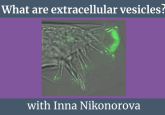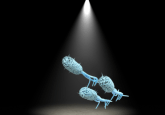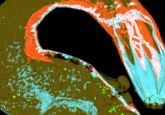Fungal hunger games: nutritional starvation in A. oligospora triggers shift from prey to predator

Scientists reveal the molecular mechanisms behind each stage of the predatory switch that the fungus Arthrobotrys oligospora (A. oligospora) undergoes in the presence of nematodes while under nutritional starvation.
Predator–prey relationships are often considered stable, but resource scarcity can prompt the hunted to become the hunters. In the Ascomycota phylum, nutritional starvation triggers a shift resulting in traps being formed in the presence of nematodes. Although many of the trapping methods are known, the molecular mechanisms behind this behavior remain unclear. In a recently published study, scientists at Academia Sinica (Taipei City, Taiwan) used time-course transcriptional profiling to understand the global gene expression patterns of A. oligospora when exposed to the nematode Caenorhabditis elegans (C. elegans), revealing several biological processes that play a role in the predatory switch of nematode-trapping fungi (NTF).
The different stages of nematode predation are broken down into sensing, trap formation, adhesion, penetration and digestion. To capture each phase, the team profiled the A. oligospora transcriptome under low nutrient conditions at various intervals following exposure to nematode prey. They found that in the presence of nematodes, NTF display a rich and dynamic transcriptomic response.
To better understand trap morphogenesis, the team conducted Gene Ontology (GO) term enrichment analysis – a technique for interpreting a set of genes by placing them in predefined bins based on their functional characteristics. The most highly enriched GO terms were “structural constituent of ribosome”, “rRNA processing”, “nucleolus” and “nucleosome”. This indicates that when A. oligospora first senses a nematode, there is a strong upregulation of ribosome biosynthesis and DNA replication in preparation for trap development.
Mobilization of secretome and effectorome assists trap development
After undertaking functional analysis of the identified genes, the researchers found an overexpression of genes involved in protein secretion, suggesting that this response involves the induction of protein secretion.
To further investigate the significance of protein secretion in fungal responses to prey, they predicted the A. oligospora secretome. They pinpointed overexpressed protein domains through expression patterns and functional enrichment analyses, finding DUF3129 to be the most prominent. Disrupting protein secretion led to traps with diminished functionality, underscoring the vital role of protein transport and secretion in trap effectiveness.
Drawing insights from pathogenic fungi studies, where effector proteins play crucial roles in infection, the researchers extended this reasoning to nematode predation. Leveraging the predicted secretome, they identified 209 putative effectors that showed differential expression in the presence of C. elegans. This finding supports their hypothesis that effector proteins manipulate nematode cellular processes or behavior during trapping.
DUF3129 gene family is essential for nematode adhesion
The team decided to probe the role of DUF3129 further. RNA-sequencing of this family revealed that several members were prominently induced in A. oligospora when exposed to nematodes. When they investigated DUF3129 gene distribution throughout the fungal kingdom, they found that this family of genes expands specifically within the NTF, suggesting an evolutionary expansion of DUF3129 that could be linked to NTF’s predatory lifestyle.
By determining the expression pattern of DUF3129 using in situ hybridization chain reaction, they showed that family genes accumulate in traps at both the transcriptional and translational levels and decided to name this family the Trap Enrichment Protein (TEP) genes.
TEP genes were hypothesized to play a crucial role in trap function and adhesion given their surface localization on trap cells. Experimental evidence supported this hypothesis, as the addition of C. elegans to traps of wild-type A. oligospora resulted in immediate capture.
 Mapping the fitness landscape of E. coli
Mapping the fitness landscape of E. coli
Researchers mapped 260,000 mutations in Escherichia coli and found it may be more capable of becoming antibiotic resistant through evolution than previously thought.
Proteases digest nematodes
Proteases break down proteins, so the researchers hypothesized that they could be important for nematode digestion. A search of the transcriptome for proteases predicted by the MEROPs peptidase database uncovered that many protease genes were highly expressed when nematodes had already been captured, which is consistent with a role in digestion.
Now that the team was on the right track, they used a protease inhibitor cocktail (PIC) to inhibit overall protease activity after trap formation and measured the growth of the hyphae, a filamentous structure emitted by fungi for digestion, inside the nematode’s body. They found that hyphal growth was delayed with PIC treatment, suggesting proteases are involved in both hyphal growth and prey digestion.
Individual investigation of proteases pinpointed two highly expressed metallopeptidase genes. While mutants of these genes could generate traps in response to nematodes, they exhibited minor defects in hyphal colonization. Collectively, these findings indicate that proteases, particularly metallopeptidases, contribute to facilitating invasive hyphal growth and colonization of nematodes.
What did we learn?
By integrating RNA-sequencing with functional analysis of candidate genes, the group was able to further the understanding of molecular and cellular mechanisms involved in NTF predation of nematodes. This study also highlighted the different biological processes that are refined by A. oligospora throughout each stage of predation. Notably, NTF exhibit an upregulation of ribosome biogenesis and DNA replication upon detecting nematode signals, undergo an expansion of the secretory pathway during trap morphogenesis, and upregulate protease and transporter gene families during prey digestion.
Their methodology lays a foundation for future investigations of the molecular mechanisms underlying predator–prey interactions between NTF and nematodes, with potential implications for understanding similar interactions in other pathogenic fungi and their interactions with plant and animal hosts.





